
|
Kuru Wooden Church  In summertime the 230-year-old wooden church of Kuru works as a road church.
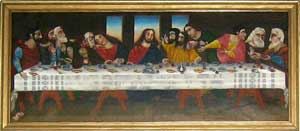 A copy of The Last Supper by Leonardo da Vinci was donated to the church of Kuru by general Georg von Moller in the beginning of the 1800's.
- Interior photos © Anita Leppälahti 27.6.2008, outdoor photo 11.7.1998, design, research, text, editing, translation © UJ 2004 - 6/2008, 28.6.2011 - The shingle roofed wooden church of Kuru was built in 1781 and planned by Matti Åkerblom or Pärnä's Matti who was born on 18.7.1740 in the Pärnä crofter's cottage in Eräjärvi Wetterkulla manor. In addition to building he learned to write and as an apprentice of a German C.F. Schröder in Turku he took a Swedish name which was customary in those days. In 1772 he is known to have worked the first time as a church builder by planning the church of Angelniemi. Among others he has planned also the churches of Teisko, Kuorevesi and Pihlajavesi and the renovation of the old church of Messukylä.
Kirkkotanhuantie 1, 33471 YLÖJÄRVI Kuru Chapel Office (fi)
Kirkkotie 2, 34300 KURU Road church open 18.6. - 29.7.2012 daily at 11.00-17.00.
Driving instructions from Tampere (en) Before the year 1666 Kuru was part of the mother church of Ruovesi, which was in the 1560's separated from Pirkkala. In 1666 Kuru became the subordinate chapel of Ruovesi with a sermon house or church cabin of its own. Kuru was, according to the consent 11.11.1872 given by the senate, separated from Ruovesi, but functioning as an independent parish started not until Kuru on 1.6.1893 got its first vicar, August Mauri Numminen (matr. 25.5.1882), the assistant vicar from Ruovesi, who held the post till his death 1945. After the municipal merger on 1.1.2009 Kuru parish returned back to a subordinate chapel - till then its functioning as an independent parish had lasted for 115 years and 7 months. The Sermon House The priests from Ruovesi came to officiate the church services in the sermon house at the same location as the present church. The sermon house must have been built soon after becoming a subordinate chapel - by the inventory 1775 apparently the same year -, and the building is known to have tarred or done some kind of a renovating to it already in the year 1681. Its measures were By the inventory of the sermon house dated on 19.9.1697 there was on the altar a red broadcloth and a linen combined of towels and edged with embroydery. There was also among all a communion chalice, a chasuble, two surplices, a bearskin, a Bible in Finnish, a wine bottle of pewter, an offertory bag and in the pulpit a quadruple hourglass for measuring time. Sources in Finnish
Erkki Laitinen, Kurun historia 1867-1918, Kurun kunta, 1988 Further Information
Agricola History Database, UTu [Unless mentioned otherwise most of the links on this page are only in Finnish.] In the 1720's as lighting was mentioned a wooden candlestick with 12 branches and a brand new chandelier of iron with 17 branches. In the sermon house there was also a sacristy for the subordinate chapel's property and a bell in the bell tower.
In 1700 there were 27 households within the area of the subordinate chapel of Kuru, the population increased all the time and the sermon house started gradually becoming close. Finally in 1778 the sermon house was demolished from under a new building when they built in Kuru a real church. It was planned by a building master Pehr Winnberg from Sastamala, but it was destroyed in a fire lit by lightning already on 20.7.1779. Gustaf Adolf's Church After the accident a new church was necessary again. The plans for this purpose were asked from a building master of churches, Matti Åkerblom, whose sister's son Matti Åkergren later supervised the construction work. The facade and floor plans were sent on 28.10.1779 to the Chief Intendent's office in Stockholm for the approval of the king. There were three different plans for the church, none of which were carried out as such, but by picking this and that from here and there. The construction work was started on their own in 1781 without the final agreement from the Chief Intendent's office, and already the same year, on the 30th of September, it was inaugurated as Gustaf Adolf's Church after an earlier king of Sweden (en). 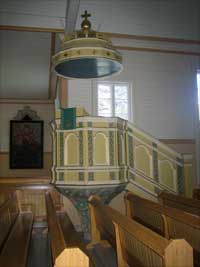 The 6-paned small window has been added behind the pulpit in the beginning of the 1800's on request of the vicar Isak Polviander to ease reading the text of the sermon.
The church of Kuru is part of the Finnish southwestern tradition of wooden churches. Its shape is of a long church, where the sacristy is on one side and the armory on the other. The bell tower is a fixed part of the building. The church of Kuru has been described as one of the most beautiful wooden churches, whose special characteristics is the tower influenced by Netherlandic renaissance and Italian baroque. Its onion-dome is thought to have based on Turku Cathedral (en), where such a new tower was built in 1759. On the other hand, all the churches planned by Åkerblom have the same onion-shaped tower typical to the Finnish southwestern churchbuilding tradition. The Bell Tower and the Sacristy In 1848 the church was weatherboarded and painted with red ochre. Two years earlier the new sacristy had been built in the eastern gable in its present place. There was space for the church's property and below it was built a wine cellar. Originally the sacristy had located in the northern gable of the church.  The altarpiece is painted by a Swedish painter J.Z. Blackstadius in Florence in 1852.
The sacristy or vestry is a rest room for the priests and a place for safe-keeping the items needed in the sermons. The word sacristy is derived from the plural form sacra of a Latin word sacer, which means holy items. The bell tower has two bells, of which the smaller one was brought from Stockholm in 1782. The bigger one was bought in 1821 from St. Petersburg and remoulded in 1935. 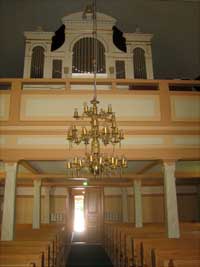 The chandelier donated by Antti Toikkonen and the organ bought in 1894 from Kangasala.
The Altarpiece depicting Christ on the cross is painted by a Swedish painter J.Z. Blackstadius (14.3.1816 - 25.2.1898) in 1852 in Florence. The fee for painting it was 200 silver rubles. Its framework with columns was designed by Kaarlo Pyydysmäki, member of a Diet and owner of a landed estate to equip a cavalryman. Blackstadius has painted among others also the altarpiece of Hämeenkyrö church. A copy of The Last Supper by Leonardo da Vinci above the door of the northern wing of the church was donated to the church of Kuru by general Georg von Moller in the beginning of the 1800's. The name of the painter of the copy is not known. The Chandeliers and the Organ The chandelier with 35 branches closest to the gallery was donated by shopkeeper Antti Toikkonen from Kuru in 1863. There is in the chandelier a writing, which says that
The parishioners of Kuru bought in 1859 the chandelier with 48 branches above the cross-aisle and the chandeliers with 24 branches in the wings were donated by farm-owners E. Ikonen in 1880 and J. Vanhakylä with J. Ylä-Kapee in 1881. The chandelier with 24 branches closest to the altarpiece was donated by agronomist Fredrik Idman in 1917. 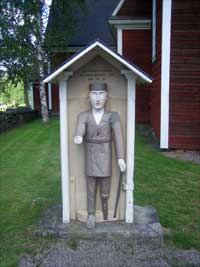 Queen Kristina (en) told in 1649 to build poorboys in public places to gather pecuniary support for poor people. The text above the poorboy's head says: "He that hath pity upon the poor lendeth unto the Lord. Proverbs 19: 17".
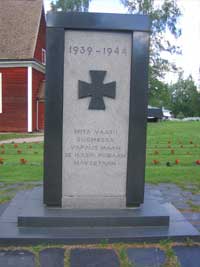 The text in the War Hero Monument says: "What the Freedom of the Country Demands Will be Payed from Father to Son".
After the mid-1800's the church started again feeling close. To ease the situation a gallery was built above the western door in 1894. From the Kangasala Organ Factory was still the same year bought the organ with 11 stops, which cost 7 400 marks. With coefficient 4,3447 the purchase would have in 2006 been worthy of 32 150,78 € or about In Aamulehti on 8.5.1887 the organ plan was written about that
Finally on 11.4.1894 B.A. Thule from the Kangasala Organ Factory informed in his letter that
Only three organs like this made in Kangasala Organ Factory exist any more, two of which are in Finland. To take this old organ again in regular use instead of the digital one has been round about 2010 under consideration in Kuru. Changes and Repairs The first major changes were the enlargening of the church windows in 1842 and building a new sacristy in 1846. Two years later the church was painted outside with red ochre and inside in 1850 and the roof was repaired in 1864. The renovation was made in 1905-1906 under supervision of architect Lars Sonck (en). Even after that number of minor and major repairs have been made: among all the electricity was installed in the mid-1940's, the roof has been tarred regularly and the outer walls painted, digital organ was bought in the 1990's into the church and in 2008 into the chapel of the new cemetary, last time the church was painted inside in 2001 with the original brown and beige colours. 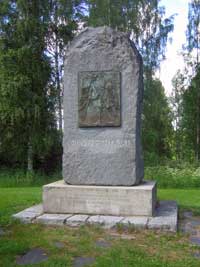 The text in the base of the Elk Hunter monument says: "To Honour Brave Matti of Kuru by J.L. Runeberg and the Pioneers of the Native Place 22.7.1956".
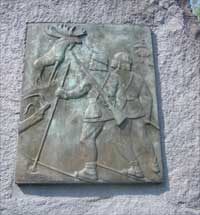 The Elk Hunter monument and relief were unveiled on 22.7.1956.
Churchyard The Wooden Poorboy Poorboy is a phenomen which has appeared only in Sweden and Finland. It has been called by many different names in different parts of the country: roughly translated like poorman, poorboy, poorgun, churchman, wooden old man and in Swedish fattiggubben like poorman. According to the local oral tradition the latter sculptor himself called his old man a silent guy. In summer 2010 the wooden poorboy had suffered from hard times and was after repairs moved indoors into the church porch next to the old stocks. Churchboat Kapee In each pair of oars there were two oarsmen, but seats for three, which made space for 30 people altogether. Below the seats there was space for travelling baskets, where the church skirts and kerchiefs, hymn books, lunch boxes and possible purchases for home were kept. Towards the church they rowed restfully but on the way home it became a competition. It has been told that the villagers from Kapee always won those from Murole because their women were tough rowers. Monuments Inspired by the Runeberg-tradition already about 20 years earlier the idea to erect a monument honouring the Brave Matti from Kuru of the poem Elk Hunter hastened in the 1950's. The father and the central organizer of the monument project and the chairman of the monument committee of 16 members was Tauno Peltomäki, an author and a summer resident from Kuru. On planning the monument they arranged a competition, which was won by a sculptor Kosti Sartti, and the festive unveiling of the Elk Hunter -monument took place on 22.7.1956. At the same time they celebrated also 175 years of the church of Kuru and 75 years of the old school of Keihäslahti (en). 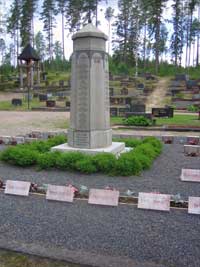 In the new cemetery there is the monument of those who were deceased in the shipwreck of s/s Kuru on 7.9.1929.
The New Cemetary The congregations since the beginning of the Middle Ages used to bury their deceased ones under the floors of churches and sermon houses. So they did also in Kuru till the year 1776, when the space started getting cramped. For a while a part of the churchyard was used as a cemetery, where also those 146 soldiers from Kuru killed at war were buried. In the year 1858 the old cemetery near the Hoppasoja ditch was grounded, but gradually even that place became cramped. The new cemetery in Tammikangas and its chapel were inaugurated in 1904 and now the old one is used only for burials in family graves. Even the new cemetery has become necessary to be widened twice in 1956 and 2002 after its grounding. Look at and Listen to the interviews (fi) by Aamulehti about the shipwreck. One of them shows also the monument in the cemetery of Länsi-Teisko. [To do so you need Adobe Flash Player. You may download the latest version on Adobe's page if you don't have it.] In the new cemetery there is also the common grave of 38 victims who lost their lives in the s/s Kuru shipwreck on 7.9.1929. The burial took place on 22.9.1929, and the next year the monument representing the Siilinkari lighthouse was erected on the grave, the funds for it were raised as a contribution from the parishioners of Kuru. The accident took altogether 136 lives, 45 of them from Kuru and 25 from Länsi-Teisko, i.e. 70 people from the whole Kuru municipality area before the year 2009. It still is the most disasterous shipwreck of all times in our country. There are monuments of the shipwreck also in Tampere. In the cemetery of Kalevankangas on a common grave of 28 victims from Tampere stands a 3 m high monument made of gray granite of Kuru. It was unveiled in 1930 and designed by Kirsti Liimatainen, who is also known as a postcard artist. On the top of the Näsinkallio cliff stands a bronze monument on a base made of black granite of Kuru and unveiled on the 11. anniversary of the shipwreck on 7.9.1940. The monument represents mother with her two children fighting against wind, it was designed by Yrjö Liipola (en) and its height together with its base is 8,5 m.
|




